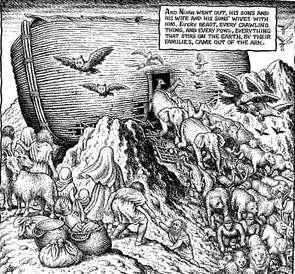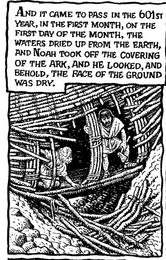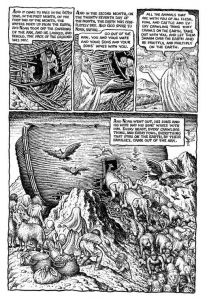Visual Thrills
By Joyce K. Schiller, Curator, Rockwell Center for American Visual Studies
Robert Crumb (b. 1943)
Cheap Thrills 1967
Album cover for Big Brother and the Holding Company
The cover art of the Cheap Thrills album is one of the icons of the 1960s counter culture, and easily gave cartoonist R. Crumb a place in the pantheon of illustration art. I love that the font Crumb utilized for the album title and the group’s name, looks like the visual equivalent of Janis Joplin’s sound—a voice that conveys the illusion that it is roughened by scotch and smoke. True to the function of illustration, the album cover illuminated some the songs offered inside: from the cigar-smoking, care-worn Bowler-hatted turtle reading the racing form illustrating “Turtle Blues,” to the black and white striped prison dress-wearing caricature of Janis dragging a “Ball and Chain” attached to her ankle behind her, Robert Crumb makes the imaginings of the songs sing over the surface of the album cover. Crumb’s recognizable sexualized femme figures with their pronounced nipples and resplendent boobs are as comfortably portrayed on this cover, letting us know, for example, that she “Need(s) a Man to Love,” as they were in Crumb’s underground comix. This may have been Crumb’s first album cover design, but it certainly was not his last.
Fast forward four decades and while Crumb’s style of characterization remains much the same, even as the focus of his pen and ink art was decidedly different. In 2009 Crumb’s The Book of Genesis Illustrated provided us with a new way to picture the stories of the first book of the Bible while the English text reflects Robert Alter’s translation of Genesis as well as the King James Version of the Bible. There is considerable sexuality and violence in Genesis, so perhaps it was in part those aspects of the first book of the Five Books of Moses that attracted the artist to this project, although Crumb did say in a 2009 interview for Vanity Fair, “I didn’t want to show sex organs, cause then the thing becomes X-rated and it limits the sales.” *
Like most of us raised in the 30s, 40s, and 50s, it is easy to see that Crumb’s images of God owe a considerable debt to the physiognomy of the actor Charleton Heston when he played the character of Moses in the 1956 movie, The Ten Commandments.
Robert Crumb (b. 1943) author, Guyart des Moulins
Illustration for Chapter 1: When God began to create God creating the heavens and earth, and land and sea
heaven and earth, page 1 Story illustration from the Bible Historiale of
Story illustrations for The Book of Genesis Illustrated John the Good, c. 1350 – before 1356
by R. Crumb, (2009) British Library, Collection of Illuminated MSS
For the opening of the first chapter of the book, when the focus is on God creating heaven and earth and everything in between, Crumb illustrated an undifferentiated void massed and spiraling between God’s hands. While this is more personalized than the same sort of image in medieval manuscripts, it still owes a debt to their vision of the cosmos and formation of the earth.
One of the places in the book where Crumb’s artistry is unique, is his interpretation of Noah’s ark. Notice the details of construction in the image below where Noah is described as taking the covering off the ark. The ship’s framework appears made of ribs constructed of bundled rods of wood. Where some of the hull covering has been removed so that Noah could check out the ground you can see that Crumb imagined an inner hull and an outer hull, both constructed of horizontal lengths of wood poles lashed together. While neither of these hulls would have been perfectly water-tight, the two would have worked together to create a floatable boat.
Details of Illustrations for Chapter 8: 13-19
Story illustrations for The Book of Genesis Illustrated by R. Crumb, (2009)
Ink and correction fluid on paper.
At the bottom of that same page, Crumb illustrated a more distant view of the ark as the assembled animals off-load. In the left foreground, Noah’s family has gathered on a hill, and mostly standing with their backs to the picture-plane, they watch the procession of the animals as they leave the ark. A variety of details in this frame provide a bit of visual resonance. For example, the large two storage baskets in the foreground, resting on the hill, are the visual equivalent of the ark in that they are similarly constructed out rushes or straw of some sort similar to the way the ark was constructed and their purpose, holding something that was precious, was the same. The other rather obvious visual comparison is the gender paring of the beasts and animals as well as the people—referring to God’s providing coupled creatures to ensure the repopulating of the earth. But notice how Crumb has some of the creatures with faces that resemble humans—and not just the gorillas and sloths in the right foreground. The owls in flight have humanistic faces and the antlered deer appears to be speaking to its unseen partner. The pair of ostriches seem to look at one another as they exit the ark. In all Crumb envisioned an orderly exit as the animals head out to “. . . swarm over the earth and be fruitful and multiply. . . .”
Robert Crumb (b. 1943)
Illustrations for Chapter 8: 13-19
Story illustrations for The Book of Genesis Illustrated by R. Crumb, (2009)
Ink and correction fluid on paper.
Despite those who object to R. Crumb’s essential earthiness, his varied contributions to American visual culture are inarguably important. Keep on Truckin’.
Robert Crumb (b. 1943)
Keep on Truckin’, 1968
Story illustration for Zap Comix, first issue
* “Robert Crumb Thinks God Might Actually Be Crazy” Interview with Robert Crumb by Eric Spsitznagel in Vanity Fair (October 22, 2009).
August 14, 2014
By Joyce K. Schiller, Curator, Rockwell Center for American Visual Studies, Norman Rockwell Museum














